What’s Up?
Bob Eastman and I had a great first morning at Sebastian. Aside from a zillion Ospreys fishing the inlet, a cooperative white Morph Reddish Egret on the beach made our day. The afternoon looked like bird photography death with a strong SE wind and sunny blue skies but I scouted around and found a fabulous afternoon spot with lots of tame wading birds, many of them in the shade. I hate to give up even on a single session. There is still lots of room in our lovely AirBbB just 22 minutes from the inlet. Get in touch via e-mail to explore the possibility of joining us.
One of the great advantages of joining me on an IPT or an Extended IPT is that I will get to look at and process your best images while creating a screen capture Camtasia video to share with you and the group. The image optimizations for all seven of todays images were done by yours truly, Arthur Morris/BIRDS AS ART.
Geri’s images show just what can be done with “just” the Sony FE 200-600mm f/5.6-6.3 G OSS lens (at 600mm) and The One, the Sony Alpha 1 Mirrorless digital camera. ) If you would like to learn more about switching to Sony, please get in touch via e-mail.
I was glad to learn that Karen McCormick sold her brand new Sony 600mm f/4GM lens for the full asking price within an hour of it being listed. She still has a great a9 iii for sale.
Today is Wednesday 30 October 2024. We will be heading back to the state park well before sunrise. I hope that all of you boys and girls have a wonderful day too. Today’s post featured the work of longtime friend and student Geri Georg of Colorado. She joined me for both the DeSoto IPT last spring and Extended IPT at Nickerson Beach. As with many, many others, I helped Geri transition from Canon to Sony about two years ago.
Please remember to use the B&H links that are found on most blog pages and to use the BIRDSASART discount code at checkout when purchasing your new gear from Bedfords to get 3% back on your credit card and enjoy free second-day air FedEx. Please, also, consider joining a BAA IPT. You will be amazed at how much you will learn!
If an item — a Delkin flash card, or a tripod head — for example, that is available from B&H and/or Bedfords, is also available in the BAA Online Store, it would be great, and greatly appreciated, if you would opt to purchase from us. We will match any price. Please remember also to use my B&H affiliate links or to earn 3% cash back at Bedfords by using the BIRDSASART discount code at checkout for your major gear purchases. Doing either often earns you free guides and/or discounts. And always earns my great appreciation.
Supporting My Efforts Here
If you enjoy and learn from the blog, are all set for gear, or live overseas, consider leaving a BAA Blog Thank You Gift here.
If you enjoy and learn from the blog, please consider using one of my affiliate links when purchasing new gear. It will never cost you a single penny. To support my effort here, please order from B&H by beginning your search here. Or, click here, to order from Bedfords and enter the discount code BIRDSASART at checkout to receive 3% cash back to your credit card and enjoy free Second-Day Air Fed-Ex shipping. It is always best to write for advice via e-mail.
In many cases, I can help you save some serious dollars. And/or prevent you from purchasing the wrong gear from the wrong shop.
Save 15%!
If you’d like to try out a new lens or if you need a lens for a specific trip or project (or for an IPT), LensRentals.com is the only way to go. To save 15%, simply click on the logo link above, arrange for your rental, and type in BIRDSASART15. If you type the gear you are looking for in the search box, it will pop right up. LensRentals.com offers affordable insurance. You can decline it, opt for LensCap: Damage Only, or select LensCap: Damage & Theft. Then hit PROCEED TO CHECKOUT. After you enter all of your info but before completing your order, be sure to scroll down to Promo Code box and enter the BIRDSASART15 code to save 15%.
I checked on renting a Sony FE 70-200mm f/2.8 GM OSS II lens for a week. The cost is only $122.00. LensCap: Damage Only coverage can be added for a very low $18.00. Going with LensCap: Damage & Theft would be $27.00. The shipping charge varies. They offer an interesting program called Lensrentals HD. By signing up for this shipping discount program ($99.00/year), you’ll get free Standard Shipping on all the orders you place.
Renting a Sony 600mm f/4 GM OSS lens for a week will cost you $536.00. The two coverage options come in at $76.00 or $114.00. Less your 15% discount when you enter the BIRDSASART15 code into the Promo Code box at checkout and enter the BIRDSASART15 code in the Promo Code box at checkout to save 15%.
Remember, to save the 15% on your rental you must start your search by clicking on the logo above, or on this link: LensRentals.com
Canon EF 70-200mm f2.8L IS II USM Lens
Mark Harrington is offering a Canon EF 70-200mm f2.8L IS II USM refurbished by Canon to Like-New condition for a very low $850.00. The sale includes the lens with front and rear caps, original product box, manual and software, Lens case LZ1326 and Lens Hood and insured ground shipping via major courier to lower-48 US addresses only.
Your item will not ship until your check clears unless other arrangements are made.
Please contact Mark via e-mail at e-mail or by phone at 1-612-308-5776 MST.
The Canon RF 70-200mm f/2.8 lens is an abomination. Why? Because the lens does not accept either teleconverter. Hard to believe, but true. If you shoot Camon mirrorless you are far better off with this lens and the EF to RF Adapter. Thus, the versatility of this popular lens is wrecked.
The versatile 70-200mm f/2.8 lenses have long been big favorites of many nature photographers. They are great for landscapes especially with fall color peaking in many areas. I have used this lens with Canon and Nikon and SONY. I used my Canon version to photograph granddaughter Maya’s dance recitals and to create bird-scapes and pre-dawn blast-off blurs at Bosque del Apache NWR in New Mexico. They are fast and sharp and have 1000 uses. The 70-200 f/2.8 lenses are a specialty lens for bird photographers. Like the bad little child, when they are good, they are really, really good! I’ve used mine mostly for flight photography at point blank range where their performance is unmatched, especially in low light. I’ve killed with these lenses on the gannet boat in the UK, in Homer for eagles, for pre-dawn and blizzard blast-offs at Bosque, and at Merritt Island on feeding sprees right next to the road. Lenses in this class are easily hand holdable by just about everyone. artie
ps: To see what the 70-200 zoom lenses can do, see the blog post here.
|
|
|
This image was created on 14 August 2024 on a Nickerson Beach Extended IPT by friend and multiple IPT veteran Geri Georg. Standing, she used the hand held Sony FE 200-600mm f/5.6-6.3 G OSS lens (at 600mm) and The One, the Sony Alpha 1 Mirrorless digital camera. ) The exposure was determined using Zebra technology with ISO on the Thumb Dial. ISO 800. 1/4000 second at f/6.3 (wide-open) in Manual Mode. AWB at 6:11:52pm on a sunny afternoon. RawDigger showed the raw file brightness to be perfect. Zone AF-C with Bird Face/Eye Detection performed perfectly. Be sure to click on the image to enjoy a high-res version. Image #1: Black Skimmer adult in flight
|
Shutter Speeds for Flight Photography
From where I sit, 1/4000 second is a great first choice for flight photography. 1/2500 and 1/3200 second are fine for most flying birds. You can often get away with 1/2000, 1/1600 or even 1/1250 second. Anything slower, and you need to pan perfectly with the bird to get the eye sharp. Some folks like 1/8000 second to completely eliminate wing tip blur. I rarely go there as I do not mind blurred wingtips as they convey motion. Remember that with film we shot flight at 1/500 second.
All that said, on rare occasion, it is possible to get the eye of a flying bird sharp at speeds as slow as 1/60 or 1/30 second. But never consistently.
Kudos for Geri to picking my favorite sunny day shutter speed for flight: 1/4000 second.
|
|
|
This image was created on 15 August 2024 on a Nickerson Beach Extended IPT by friend and multiple IPT veteran Geri Georg. Standing, she used the hand held Sony FE 200-600mm f/5.6-6.3 G OSS lens (at 600mm) and The One, the Sony Alpha 1 Mirrorless digital camera. ) The exposure was determined using Zebra technology with Exposure Compensation on the Thumb Dial. Multi Metering +2/3 stop. AUTO ISO set ISO 400. 1/8 second at f/6.3 (wide-open) in Shutter Priority mode. AWB at 6:59:25am on a cloudy morning. RawDigger showed the exposure to be 1/3 stop under. Zone AF-C with Bird Face/Eye Detection performed perfectly. Be sure to click on the image to enjoy a high-res version. Image #2: Black Skimmer flock blastoff blur
|
Getting Out Early
If you are walking down to the beach when it is still dark, blurs are often your only choice until the sun comes up. On IPTs, when blurs are on the table and the backgrounds are consistently light toned, I teach folks to work in Shutter Priority mode with AUTO ISO and Exposure Compensation (EC) on a convenient dial or wheel. Kudos to Geri for being open to new concepts and especially for digging blurs. Not everyone does.
Let’s see what ISO you would have needed to get to a shutter speed of 1/2000 second that early that morning.
1/8 @ ISO 400
1/15 @ ISO 800
1/30 @ ISO 1600
1/60 @ ISO 3200
1/125 @ ISO 6400
1/250 @ ISO 12800
1/500 @ ISO 25600
1/1000 @ ISO 51200
1/2000 @ ISO 102400
Necessity is often the mother of invention when it comes to photographing in extreme low light conditions. Blurs anyone?
|
|
|
This image was created on 16 August 2024 on a Nickerson Beach Extended IPT by friend and multiple IPT veteran Geri Georg. Seated on dry sand, right next to me, she used the hand held Sony FE 200-600mm f/5.6-6.3 G OSS lens with the Sony FE 1.4x Teleconverter (at 840mm) and The One, the Sony Alpha 1 Mirrorless digital camera. ) The exposure was determined using Zebra technology with ISO on the Thumb Dial. ISO 1250. 1/1600 second at f/9 (wide-open) in Manual Mode. AWB at 9:23:45am on a barely cloudy very bright morning. RawDigger showed the raw file brightness to be perfect. Zone AF-C with Bird Face/Eye Detection performed perfectly. Be sure to click on the image to enjoy a high-res version. Image #3: Black Skimmer — large chick barking
|
200-600 with the 1.4X TC
As the birds were not letting us get very close, I suggested to Geri that she add the 1.4X to get more pixels on the bird. She did, and she did. Not all students listen to the instructors suggestions 🙂 Good on Geri!
|
|
|
This image was created on 17 August 2024 on a Nickerson Beach Extended IPT by friend and multiple IPT veteran Geri Georg. Seated on dry sand, she used the hand held Sony FE 200-600mm f/5.6-6.3 G OSS lens (at 600mm) and The One, the Sony Alpha 1 Mirrorless digital camera. ) The exposure was determined using Zebra technology with ISO on the Thumb Dial. ISO 8000! 1/1250 second at f/6.3 (wide-open) in Manual Mode. AWB at 7:58:39 am on a very cloudy morning. RawDigger showed the raw file brightness to be perfect. Zone AF-C with Bird Face/Eye Detection performed perfectly. Be sure to click on the image to enjoy a high-res version. Image #4: Osprey directly overhead staring at photographer
|
You’ve Heard This One Before
When the shot is there, press the shutter button; if you try to change anything, you will wind up with nothing. Above, I suggested that 1/4000 sec. is a great choice for flight photography. When Geri saw the Osprey above looking right down at her, she pressed the shutter button despite the relatively slow of flight shooting shutter speed of 1/1600 sec. Then, she got a bit lucky. The better your hand holding sharpness techniques, the luckier you will get.
|
|
|
This image was also created on 17 August 2024 on a Nickerson Beach Extended IPT by friend and multiple IPT veteran Geri Georg. Seated right next to me on damp sand, she used the hand held Sony FE 200-600mm f/5.6-6.3 G OSS lens (at 600mm) and The One, the Sony Alpha 1 Mirrorless digital camera. ) The exposure was determined using Zebra technology with ISO on the Thumb Dial. ISO 5000! 1/2500 second at f/6.3 (wide-open) in Manual Mode. AWB at 10:00:52am on a cloudy morning. RawDigger showed the raw file brightness to be perfect. Zone AF-C with Bird Face/Eye Detection performed perfectly. Be sure to click on the image to enjoy a high-res version. Image #5: Black Skimmer adult jumping up after bath
|
Wind Direction and Bathing Birds
Bathing birds will almost always jump into the air at the end of their bath; those that do will always jump up and flap while facing into the wind, just as they do when taking flight. We stayed late on a stormy morning and used the NE wind to our advantage while working a receding tidal pool.
|
|
|
This image was created on 18 August 2024 on a Nickerson Beach Extended IPT by friend and multiple IPT veteran Geri Georg. Seated on dry sand, she used the hand held Sony FE 200-600mm f/5.6-6.3 G OSS lens (at 600mm) and The One, the Sony Alpha 1 Mirrorless digital camera. ) The exposure was determined using Zebra technology with ISO on the Thumb Dial. ISO 800. 1/1600 second at f/6.3 (wide-open) in Manual Mode. AWB at 1:19:30pm on a cloudy day. RawDigger showed the raw file brightness to be perfect. Zone AF-C with Bird Face/Eye Detection performed perfectly. Be sure to click on the image to enjoy a high-res version. Image #6: Black Skimmer large chick begging posture
|
Why Were We on the Beach at 2pm?
It was pouring rain when we woke up in our AirBnB on Lido Beach, Long Island, NY. We worked on images for a few hours and when the rain quit and the sky brightened just a bit, I said, “Let’s go. We’ll see if they are letting folks in for free because of the bad weather. They were and we had a great afternoon session.
|
|
|
This image was also created on 18 August 2024 on a Nickerson Beach Extended IPT by friend and multiple IPT veteran Geri Georg. Seated on dry sand right nest to me, she used the hand held Sony FE 200-600mm f/5.6-6.3 G OSS lens (at 600mm) and The One, the Sony Alpha 1 Mirrorless digital camera. ) The exposure was determined using Zebra technology with ISO on the Thumb Dial. ISO 250. 1/1600 second at f/6.3 (wide-open) in Manual Mode. AWB at 2:10:47pm on a cloudy day. RawDigger showed the raw file brightness to be perfect. Zone AF-C with Bird Face/Eye Detection performed perfectly. Be sure to click on the image to enjoy a high-res version. Image #7: Black Skimmer adult feeding large chick
|
The Feeding Shot!
Tern and skimmer chick feeding shots are difficult to impossible for two main reasons:
1- The odds of getting two good head angles is always at least four to one against you.
2- Getting a decent look at the faces of both the adult and the chick is very challenging.
3- Having both the adult and the chick nicely juxtaposed with regards to the imaging sensor might be the biggest challenge of all.
Kudos to Geri on all counts for Image #7. And big time thanks for allowing me to share your work with the boys and girls here on the blog.
Typos
With all blog posts, feel free to e-mail or to leave a comment regarding any typos or errors, or to ask a question.

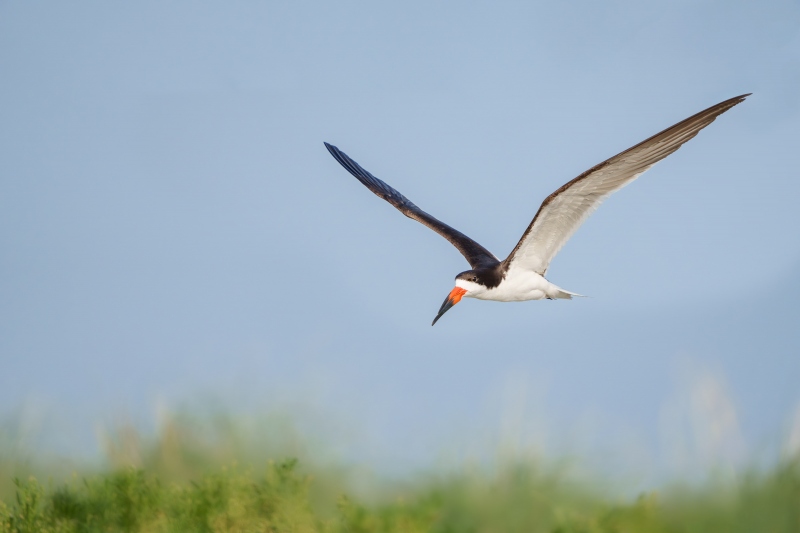
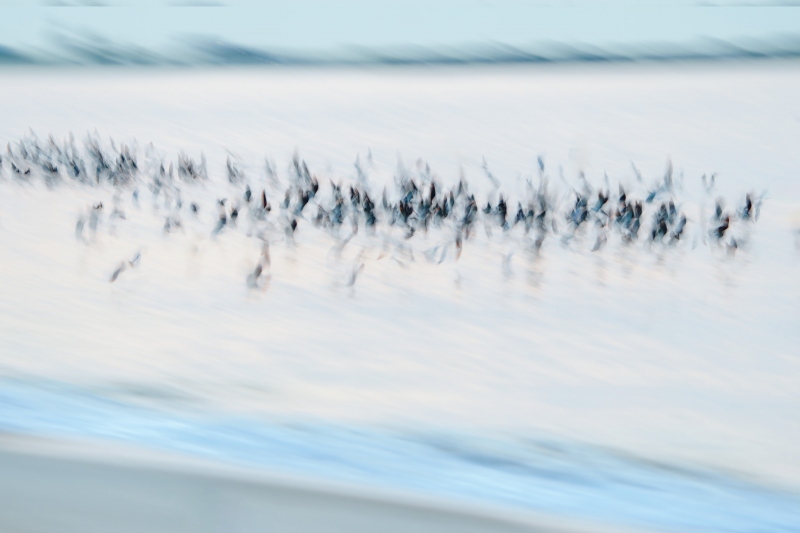
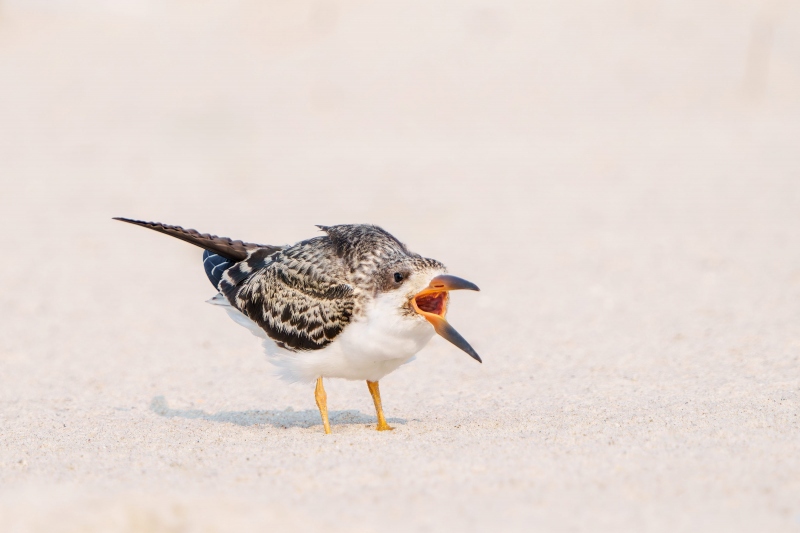
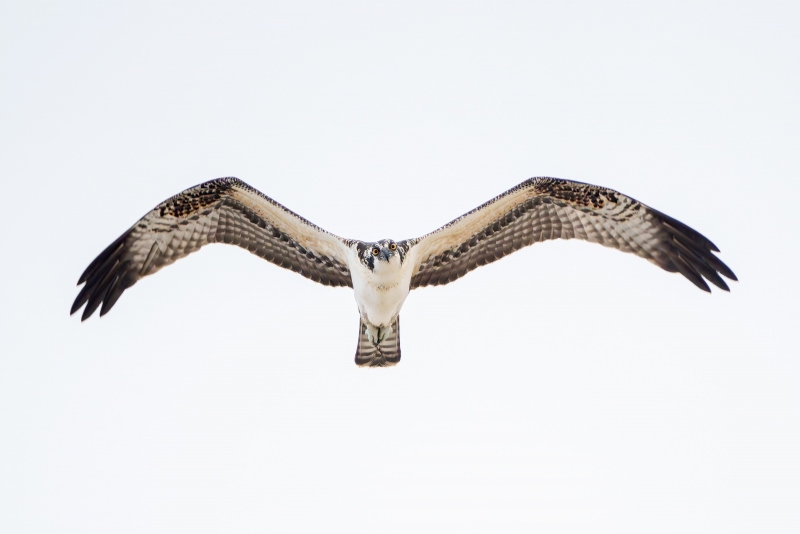
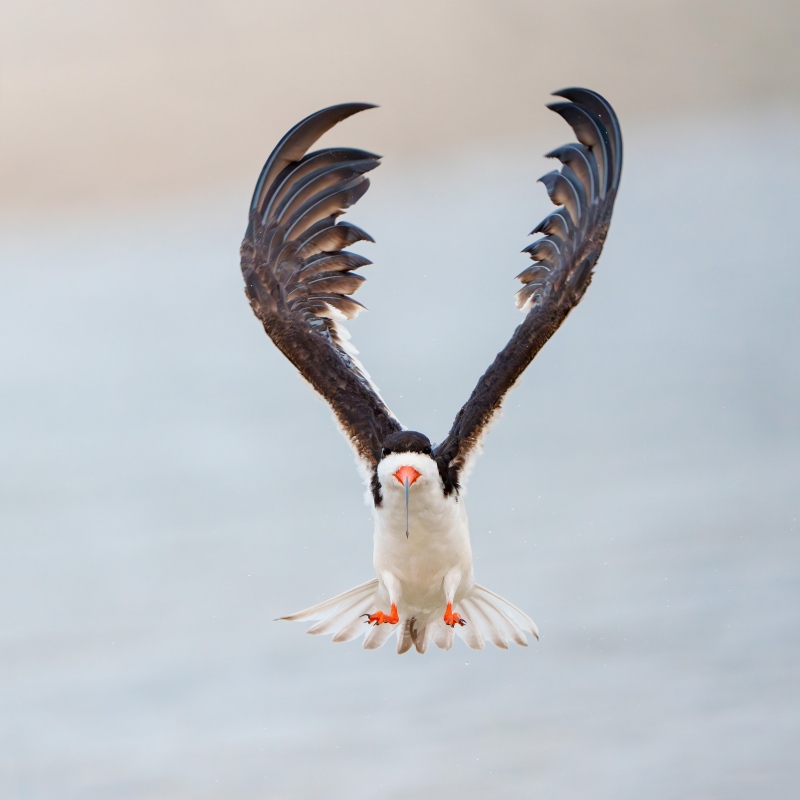
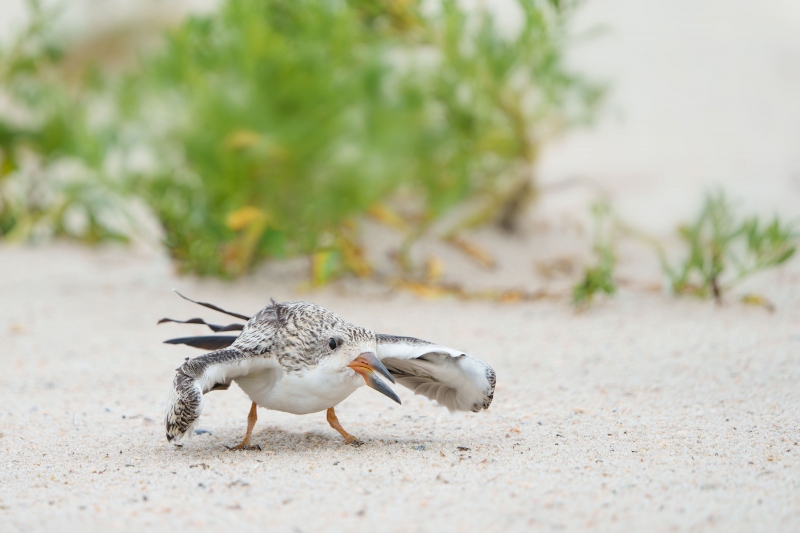
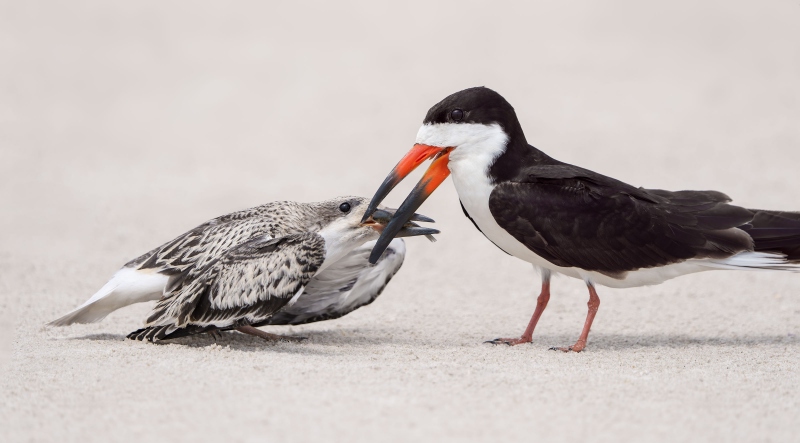













Bob and Cliff, Thank you both for your erudite comments.
much love, a
ps: Bob is sitting right next to me as we are on the way to the inlet in the dark on Thursday morning.
Artie
Hi Geri amazing photos and I do love the hard to get feeding shot #7 and #6 the little chic begging say mom feed me! The blast off blur is also pretty cool and hard to get.
Yesterday I met a man in Sebastian Inlet that was taking pictures however he really had no idea how to look at exposure or the histogram and he his gear was like $15-20K.
Artie could have taught him in just a few sessions and he would have been much “Gooder” as you know Geri Artie is the photo guru on really all brands of gear, however Sony Rocks.
Great shots Geri keep going out. 🙂
Always with love b
Artie’s exclamation gives it away: “The Feeding Shot!” Image 7 is spectacular for all the reasons stated, plus the wonderfully soft light. The wing position in image 5 is also sweet, and the other images are all solid.
Love image #5 for its unusual pose!
Thanks, Barb!
with love, artie
Thanks Artie! I always learn something new when I work with you.
Geri
Same with me :-). Sorry, I did not see this for weeks after I saw it originally and then could not figure out where!
much love, artie